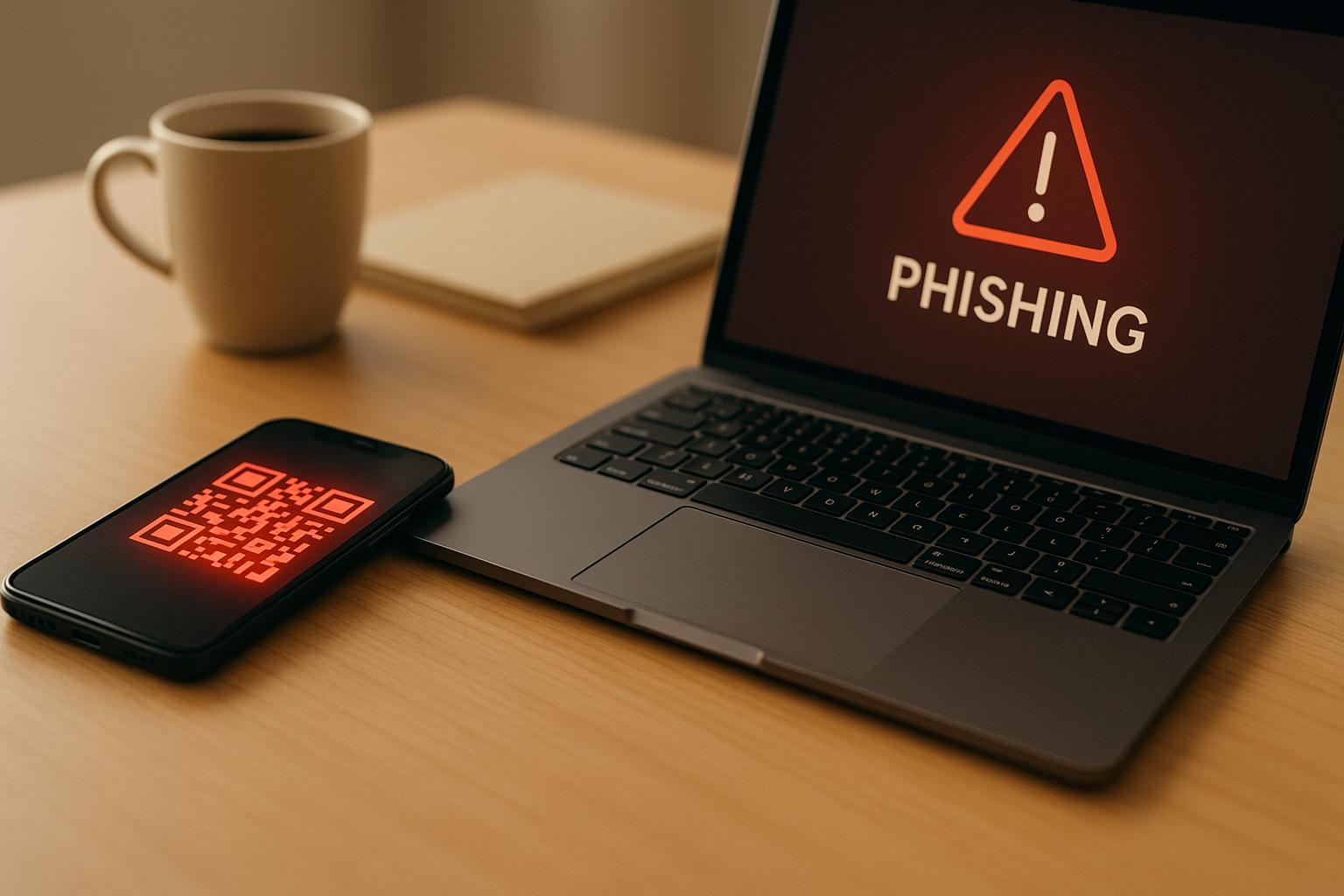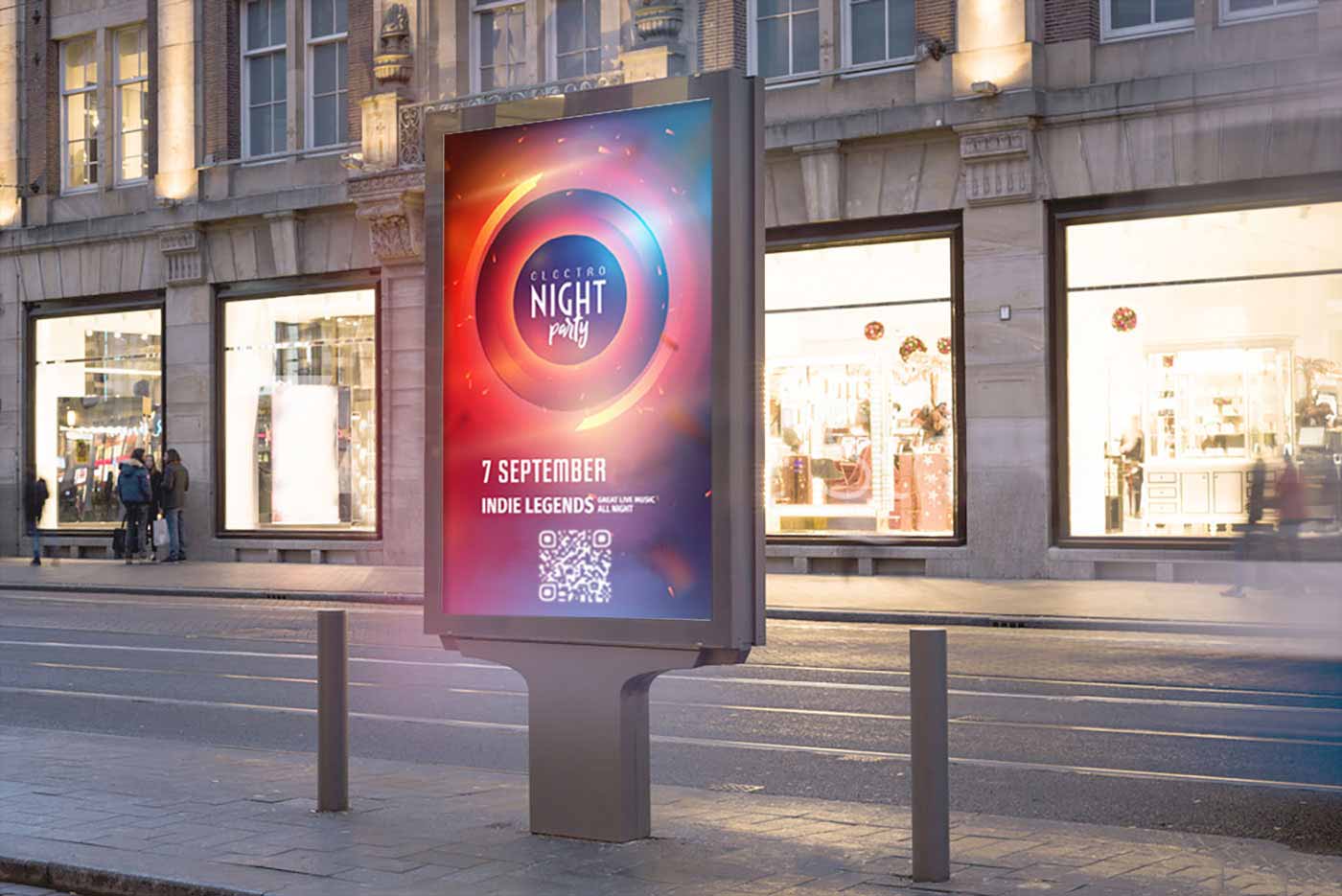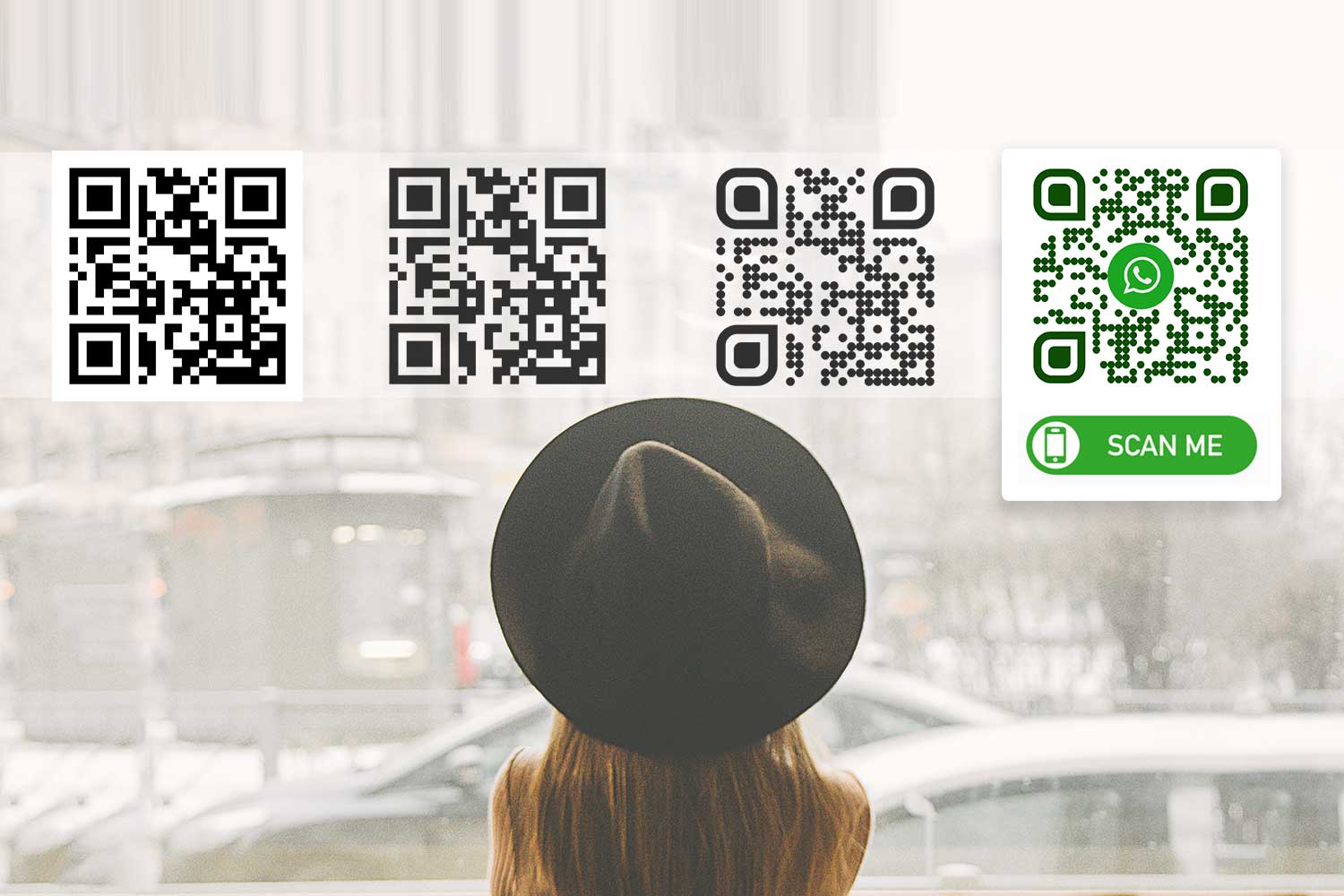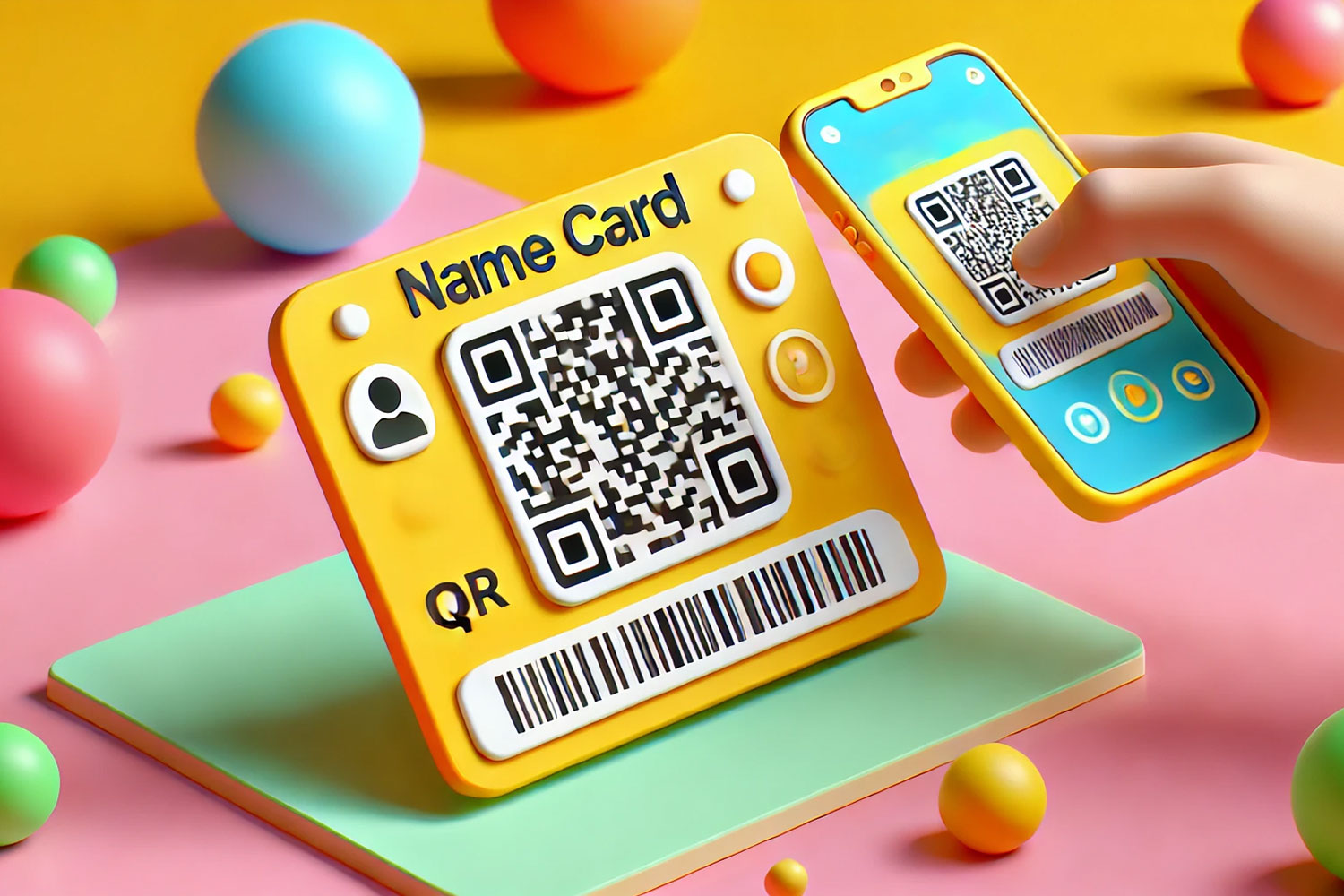QR code phishing is a rapidly growing threat in 2025, with attacks rising by 587% in recent years. Businesses are at risk of financial loss, data breaches, and reputational damage due to malicious QR codes used in phishing schemes. Here’s what you need to know:
- What is it? QR code phishing, or "quishing", tricks users into scanning codes that lead to fake websites or malware downloads.
- Why it matters: Nearly 2% of all scanned QR codes are malicious, and phishing attacks now account for 90% of all cyberattacks.
- Who is at risk? Small businesses, executives, and industries like construction and professional services are prime targets.
- How it happens: Attackers use fake QR codes in emails, public spaces, or tampered physical stickers to steal credentials or deploy malware.
Key Prevention Tips
- Train employees to spot phishing tactics and verify QR codes.
- Use secure QR code platforms with dynamic codes that can be updated or disabled if compromised.
- Conduct regular audits of deployed QR codes and have a strong incident response plan.
With QR code payments expected to exceed $3 trillion in 2025, it’s critical to act now. Protect your business by combining education, secure tools, and proactive monitoring.
How QR Code Phishing Attacks Work
How QR Code Phishing Attacks Work
QR code phishing, often called "quishing", takes advantage of the fact that QR codes are not human-readable. With a traditional URL, you can often spot something suspicious, but a QR code keeps everything hidden. Alex Mosher, global vice president at MobileIron, explains:
"QR codes inherently conceal their destination. Therefore, the ability to alter a QR code to point to an alternative resource without being detected is simple and highly effective."
This invisibility gives attackers a significant advantage. They can embed harmful URLs directly within QR codes, tricking users into visiting phishing sites designed to steal their credentials or install malware. As Cisco Talos highlights:
"QR codes evade traditional detection methods because they are displayed as images. Effective identification requires decoding the image and analyzing the resulting data, a process that many anti-spam systems are not equipped to handle."
Although about 60% of emails containing QR codes are flagged as spam, many still slip through because security filters often struggle to analyze the content embedded in QR codes.
Let’s look at how cybercriminals distribute these malicious QR codes.
Common Attack Methods
Attackers use a variety of methods to distribute harmful QR codes. Email-based attacks are one of the most common approaches. They often embed QR codes into PDFs or Word documents to bypass email security filters. In 2023, 82% of quishing attacks involved impersonations of trusted brands like Microsoft or DocuSign, exploiting the trust people have in these companies.
Another widespread tactic involves physically placing fake QR codes in public spaces. High-traffic areas like restaurants, airports, shopping malls, and parking meters are prime targets. Attackers might overlay legitimate QR codes with fake ones or replace them entirely. For instance, in San Francisco, criminals placed counterfeit QR codes on parking tickets, directing users to a fake transit page designed to steal credit card details.
Social engineering adds another layer to these schemes. Attackers often lure victims with promises of free WiFi, discounts, or prizes. In one case in Singapore in 2024, a woman scanned a QR code at a bubble tea shop, thinking it was for a survey to win a free drink. Instead, the downloaded app turned out to be malicious, allowing attackers to access her banking information and steal $2,000.
These examples show just how creative and varied these attacks can be, making it increasingly difficult for businesses and individuals to trust QR codes.
Tactics Used by Attackers
Once malicious QR codes are distributed, attackers employ several tactics to exploit their victims. These include redirecting users to harmful URLs, harvesting credentials through fake login pages that mimic legitimate services like banking portals, and using human verification schemes to mask their intentions.
One particularly tricky method is the use of PDF annotation attacks. Here, attackers embed phishing QR codes alongside legitimate-looking links to well-known services like DocuSign. These annotations make the document appear authentic, even though the QR code leads to a harmful site.
Unit 42 from Palo Alto Networks highlights the difficulty of detecting these threats:
"Embedding phishing URLs within QR codes makes it more difficult for traditional scanning engines to extract the actual URL from phishing documents."
This combination of technical challenges and users’ increasing reliance on QR codes creates the perfect storm for attackers. With QR code scans rising by 433% over the past four years and only 36% of people able to recognize QR code phishing attempts, the risks are growing at an alarming rate.
Business risks of QR code phishing
 QR code phishing, or "quishing", relies on hidden URLs to breach systems, creating serious risks for businesses across industries. The fallout from these attacks can ripple far beyond a single compromised account, affecting operations, finances, and even a company’s reputation.
QR code phishing, or "quishing", relies on hidden URLs to breach systems, creating serious risks for businesses across industries. The fallout from these attacks can ripple far beyond a single compromised account, affecting operations, finances, and even a company’s reputation.
Data and credential theft
The primary goal of QR code phishing is to steal credentials. Nearly 90% of these attacks are crafted to harvest login details and sensitive information. When employees scan malicious QR codes, they are often directed to fake login pages that mimic trusted platforms like Microsoft 365 or SharePoint.
Between mid-June and mid-September 2024, researchers at Barracuda uncovered over half a million phishing emails containing QR codes embedded in PDFs. These attacks frequently impersonated popular platforms, with Microsoft targeted in 51% of cases, followed by DocuSign at 31% and Adobe at 15%.
"Attackers can embed malicious URLs containing custom malware into a QR code which could then exfiltrate data from a mobile device when scanned. It is also possible to embed a malicious URL into a QR code that directs to a phishing site, where unsuspecting users could disclose personal or financial information." – Kaspersky
High-ranking executives are particularly at risk, as their credentials often provide access to critical systems and sensitive data. The problem worsens when employees use personal devices to scan QR codes, as these devices typically lack enterprise-level security, leaving businesses vulnerable to breaches they cannot monitor or control.
Financial and reputation damage
The financial toll of QR code phishing can be staggering. Large organizations have reported phishing-related losses exceeding $15 million, with an average cost of $1,500 per employee. Overall, direct phishing losses surged by 76%.
In 2023, the average cost of a data breach reached $4.45 million, while Business Email Compromise scams averaged $4.89 million – figures that don’t even account for regulatory fines and legal expenses. Real-world examples highlight the impact: in August 2023, a railway station scam left a victim with £13,000 in debt, and in December 2023, a family in Calgary lost $10,000 to a Facebook Marketplace QR code scam.
Beyond immediate financial losses, reputation damage can have lasting consequences. When customers doubt a business’s ability to safeguard their information, long-term revenue and market valuation can suffer. Companies may also face:
- Customer churn, as clients opt for competitors they perceive as more secure
- Higher insurance premiums for cybersecurity coverage
- Regulatory scrutiny, which could lead to compliance penalties
Small businesses are particularly vulnerable. In the UK, small enterprises face an estimated 65,000 cyberattacks daily, with the average cost of resolving a successful attack around $33,700.
Business disruptions
QR code phishing can disrupt operations by granting attackers access to systems through stolen credentials. These credentials are often used to deploy ransomware, halting business activities. In 2023, companies spent an average of $1.82 million recovering from ransomware incidents.
Certain industries face heightened risks. For example, construction and engineering firms are 19.2 times more likely to encounter QR code attacks compared to other sectors. Professional service providers are also heavily targeted, facing a risk 18.5 times higher than average. These industries frequently use QR codes for projects and client communications, making them attractive targets.
Smaller businesses are under increasing pressure, with those managing 500 or fewer mailboxes experiencing quishing attacks at rates up to 19 times higher than larger organizations. Limited cybersecurity budgets, fewer IT staff, and less advanced email filtering systems leave these companies particularly exposed. Additionally, employees in smaller businesses are more likely to have administrative privileges, amplifying the potential damage of a successful attack.
The shift to remote work has further expanded attack surfaces. Many businesses adopted QR codes for contactless interactions, such as menus, event check-ins, and customer engagement during the pandemic. However, traditional network security measures often fall short when employees scan QR codes on personal devices outside the office.
The statistics are alarming: nearly 2% of all scanned QR codes are malicious, and phishing remains a factor in 90% of all cyberattacks. For businesses that rely on QR code solutions, understanding these threats is essential to building defenses that protect both their operations and their customers.
sbb-itb-74874c9
Prevention methods and best practices
To shield your business from QR code phishing attacks, focus on employee education, secure platforms, and constant monitoring. With quishing attacks skyrocketing by 2,400% since May 2023, it’s clear that businesses need a thorough approach to address both human and technical weaknesses.
Employee training and awareness
Your employees are your first line of defense against QR code phishing. The 51% rise in quishing attacks in September 2023 underscores the importance of regular, focused training. Teach your team to recognize phishing tactics – like urgent messages, errors, or odd requests. They should also be vigilant for signs of tampering.
Emphasize the importance of verifying QR codes. Employees should confirm the legitimacy of codes using independent methods, such as calling the sender directly or visiting official websites. With projections showing 99.5 million U.S. smartphone users will scan QR codes by 2025, spotting red flags is more critical than ever. Incorporate phishing simulations with QR code scenarios into your training to keep awareness sharp. A well-trained workforce lays the groundwork for safely using secure QR code platforms.
Using secure QR code platforms
 The platform you choose to generate QR codes plays a big role in your security. Opt for trusted platforms to create QR codes that allow for monitoring and control. Dynamic QR codes are a smarter option – they can be updated, tracked, or disabled if compromised, unlike static codes. This adaptability is particularly useful for codes on business cards, flyers, or restaurant menus.
The platform you choose to generate QR codes plays a big role in your security. Opt for trusted platforms to create QR codes that allow for monitoring and control. Dynamic QR codes are a smarter option – they can be updated, tracked, or disabled if compromised, unlike static codes. This adaptability is particularly useful for codes on business cards, flyers, or restaurant menus.
Secure platforms often offer real-time analytics and scan monitoring, helping you spot any unusual activity that could signal a threat. Features like branded designs with logos can also make legitimate codes stand out from fraudulent ones. Use trusted scanning tools, and consider implementing Mobile Device Management (MDM) systems. These give IT teams more control over devices, letting them enforce security policies and monitor activity. However, selecting secure tools is just the start – continuous monitoring and regular audits are essential to stay ahead of potential risks.
Regular audits and incident response
Routine audits and a solid incident response plan are key to reducing QR code-related threats. Regularly review all deployed QR codes to ensure they haven’t been tampered with and are functioning as expected. Physical audits are also crucial – attackers can easily place malicious stickers over legitimate codes on posters, windows, or vehicles.
Strong network security measures are another layer of protection. Advanced spam filters and strict email security policies can help block phishing emails containing malicious QR codes. Two-factor authentication (2FA) adds extra security, though it’s worth noting that a Google study revealed a 24% success rate for attackers bypassing one-time passcodes. This highlights the need for even stronger authentication methods.
Penetration testing, including scenarios involving QR code attacks, can help identify weak points and improve your defenses. Make sure employees know how to report suspicious QR codes so IT teams can quickly investigate and respond to threats. Your incident response plan should specifically address QR code phishing, detailing steps like isolating compromised accounts, resetting credentials, and notifying affected individuals. While some experts suggest eliminating QR codes altogether, businesses must weigh this against the convenience and engagement they provide. Finally, keep mobile devices, scanning apps, and security systems updated to guard against new threats.
How Pageloot Helps Businesses Stay Secure

Pageloot tackles QR code phishing by addressing potential risks while maintaining ease of use.
QR Code Customization and Branding
Did you know that 71% of people can’t tell the difference between a fake QR code and a real one? That’s where branded QR codes come in. By customizing your codes with your company logo, brand colors, and unique designs, you make it easier for users to identify legitimate codes and avoid falling for malicious ones.
Custom domains take this a step further. Instead of using generic short links that might look suspicious, you can create URLs that clearly show they belong to your business. This not only builds trust but also boosts engagement – branded URLs have been shown to increase click-through rates by 34%.
Adding call-to-action frames to your QR codes enhances security even more. These frames clearly communicate the purpose of the code before it’s scanned, reducing confusion and building user confidence. Whether your codes are on business cards or marketing materials, this approach ensures users feel secure interacting with them.
Dynamic QR Code Management
Beyond branding, dynamic QR code management provides ongoing security even after your codes are out in the world. Pageloot’s dynamic QR code generator lets you stay in control, even if the codes have already been printed and distributed.
If you suspect tampering – say, on codes displayed in public spaces like restaurant menus, posters, or vehicle displays – you can instantly update the destination URL or deactivate the code. This real-time flexibility is invaluable in situations where physical tampering is a concern.
Dynamic QR codes also allow you to verify and test linked destinations. If a campaign URL or linked site becomes risky, you can edit QR codes on the fly, ensuring your codes remain secure and functional.
Analytics and Scan Monitoring
Real-time analytics add another layer of protection by tracking scan behavior, locations, devices, and timing. Pageloot’s monitoring tools can alert you to unusual activity that might signal a phishing attempt.
For instance, a sudden spike in scans from unexpected locations or unfamiliar devices could indicate that your QR codes have been copied or misused. The analytics dashboard makes it easy to spot these anomalies and take swift action.
Geographic tracking ensures scans are coming from the areas you expect. If you’re running a local restaurant campaign but notice scans from faraway locations, it could be a red flag for malicious distribution. Similarly, time-based analytics can identify suspicious patterns, as legitimate scans usually align with normal business hours.
Secure QR Code Use Cases
Pageloot’s monitored and branded QR codes are a smart choice for various secure applications, including contactless payments, event check-ins, personalized marketing campaigns, and verified resources in e-commerce, healthcare, education, and real estate.
For contactless payments, branded QR codes paired with real-time monitoring ensure transactions go to the right business. Event QR codes are harder to duplicate or tamper with, and dynamic management allows organizers to disable compromised codes or adjust processes on the fly.
Personalized marketing campaigns often involve sensitive customer data. Using branded QR codes with custom domains builds user trust, while analytics monitoring helps detect unauthorized scans. Professional services can also benefit from these monitored and branded codes, as they not only establish credibility but also track genuine customer engagement effectively.
Conclusion
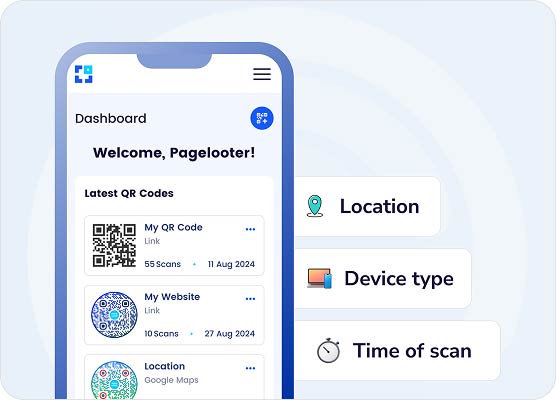 QR code phishing has emerged as a serious concern in 2025. With a 25% year-over-year increase in attacks and approximately 2% of all QR code scans being malicious, the risks are undeniable. Add to that the staggering average cost of data breaches – $4.45 million – and it’s clear why businesses need to prioritize security.
QR code phishing has emerged as a serious concern in 2025. With a 25% year-over-year increase in attacks and approximately 2% of all QR code scans being malicious, the risks are undeniable. Add to that the staggering average cost of data breaches – $4.45 million – and it’s clear why businesses need to prioritize security.
Addressing this growing threat requires immediate action. As discussed earlier, training employees, utilizing secure platforms, and maintaining proactive monitoring are key steps. Teaching your team to carefully verify QR codes through independent channels can act as a crucial first line of defense, especially since nearly 90% of QR phishing (or "quishing") attacks are designed to steal sensitive data and login credentials.
To help businesses navigate these risks, Pageloot provides a secure platform that offers advanced QR code customization, dynamic management tools, and real-time analytics. These features not only mitigate phishing threats but also allow businesses to safely use QR codes for legitimate purposes like contactless payments, marketing campaigns, and customer engagement.
As cybercriminals adopt increasingly sophisticated tactics, including AI-powered phishing techniques, the challenges will only grow. Mika Aalto, co-founder and CEO of Hoxhunt, highlights this shift:
"In the near future, AI will power significantly more phishing attacks – everything from text-based impersonations to deepfake communications will become cheaper, more convincing, and more popular with threat actors."
With QR code payments expected to surpass $3 trillion globally by 2025, businesses that invest in robust security measures now will not only protect their operations but also position themselves to take full advantage of this growing trend. By combining employee education, secure QR code tools, and ongoing monitoring, companies can ensure safe and successful digital interactions.
FAQs
How can businesses train employees to identify and avoid QR code phishing scams?
To help employees steer clear of QR code phishing scams, businesses should prioritize regular security awareness training. These sessions should aim to inform staff about the dangers of malicious QR codes, guide them on how to verify codes before scanning, and stress the importance of avoiding codes from unfamiliar or suspicious sources.
Incorporating simulated phishing exercises – like fake QR code scenarios – can sharpen employees’ ability to identify threats. Encourage the use of QR code scanning apps with URL preview features so links can be checked before being opened. Also, remind employees to engage only with QR codes from trusted and verified sources. By combining consistent training with practical exercises, organizations can strengthen awareness and reduce the chances of employees falling prey to QR code phishing schemes.
How do dynamic QR codes help protect businesses from phishing attacks?
Dynamic QR codes offer a stronger defense against phishing attacks compared to their static counterparts, thanks to their advanced security features. One standout benefit is their ability to update the destination link in real time. If a malicious link is identified, it can be swapped out immediately, minimizing potential risks. In contrast, static QR codes are permanently fixed and can’t be changed once generated.
Beyond this, dynamic QR codes come with tools for advanced tracking and analytics. These tools enable businesses to monitor scan activity and spot unusual behavior, which could signal a phishing attempt. Added features like password protection and encryption further enhance their security, making dynamic QR codes a smart choice for businesses using QR codes in marketing, payments, or customer interactions.
What steps can small businesses take to protect themselves from QR code phishing, even with a limited cybersecurity budget?
Small businesses can protect themselves from QR code phishing by following a few straightforward security measures. Start by double-checking the URL after scanning a QR code to confirm it’s legitimate. Stay cautious and avoid scanning codes from unknown or suspicious sources. Additionally, opting for reliable QR code scanners with built-in security features can help minimize potential threats.
For an extra layer of security, explore secure QR code solutions that include features like password protection, custom domains, and user access controls. Tools offered by platforms such as Pageloot allow businesses to create and manage QR codes with advanced customization options and analytics. This makes it easier to use QR codes safely while enhancing marketing efforts and streamlining operations.

